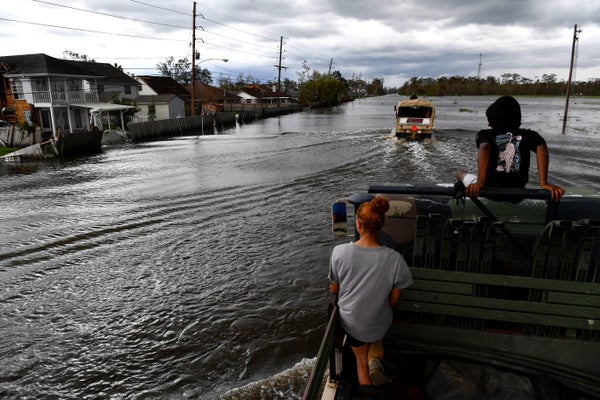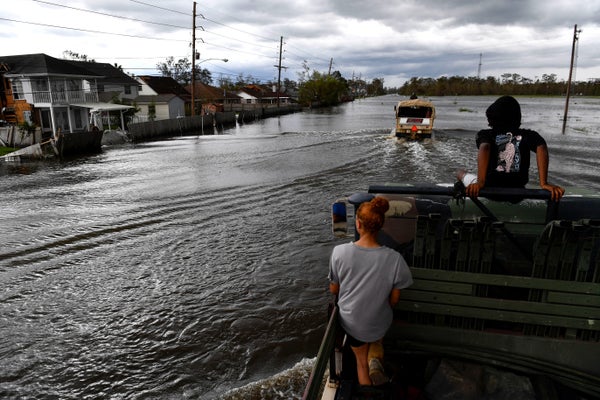
[ad_1]
Heat and Floods Are Increasingly Hitting Coastlines with a One-Two Punch
Compound events in which coastal flooding and heat waves occur at the same time are happening more often as the planet warms

A high water truck with volunteers help evacuate people from homes after neighborhoods flooded in LaPlace, Louisiana on August 30, 2021 in the aftermath of Hurricane Ida.
Patrick T. Fallon/AFP via Getty Images
CLIMATEWIRE | Heat waves and coastal floods are intensifying around the world as global temperatures rise and sea levels swell. These disasters are dangerous when they occur on their own — and even worse when they happen together.
Now scientists are warning that these “compound” events are growing more common worldwide.
A new study published in the journal Communications Earth & Environment suggests that heat waves and coastal floods frequently coincide along shorelines all over the globe. They have already grown more common over the past few decades — and they’re likely to keep increasing as global temperatures rise.
On supporting science journalism
If you’re enjoying this article, consider supporting our award-winning journalism by subscribing. By purchasing a subscription you are helping to ensure the future of impactful stories about the discoveries and ideas shaping our world today.
That’s alarming news for coastal communities threatened by compound events.
Extreme heat can drive people to seek respite outdoors, increasing their risk of injury or death during floods. And floods can knock out power, limiting access to air conditioning during heat waves.
Hurricane Ida, which ravaged the U.S. Gulf Coast in August 2021, is a prime example. Heavy rainfall and destructive storm surge caused devastating floods in southeast Louisiana, inundating local communities and causing widespread electricity outages. A sweltering heat wave set in immediately afterward, killing at least 10 people.
The authors of the new study — Mo Zhou and Shuo Wang from Hong Kong Polytechnic University — analyzed historical weather data to map out the places where heat waves and extreme sea levels have occurred together over the past few decades. They found that nearly 88 percent of all the world’s coastlines had experienced such an event at some point since 1979.
Tropical coastlines were the hardest hit. They account for less than half the world’s shorelines, but experienced more than 70 percent of the compound events the study identified.
These events have grown more common in the past couple of decades, the study adds. Nearly 40 percent of the world’s coastlines have experienced a significant increase in combination heat and extreme sea level events since 1998.
And it’s probably going to get worse. The researchers used computer models to investigate how these events might evolve as global temperatures continue to climb. Under a relatively extreme future climate scenario, global coastlines are expected to experience about 38 days of compound events every year between 2025 and 2049. That’s an average increase of 31 days compared with the average between 1989 and 2013.
It’s unclear what physical mechanisms are driving the increase. But the warming atmosphere appears to be playing some role.
The researchers found that hotter heat waves are more likely to occur simultaneously with extreme coastal sea level events. Heat waves are already growing more severe all over the world. The researchers also found that compound events tended to occur during specific atmospheric conditions, such as higher temperatures and swirling low-pressure systems, which often turn into coastal storms.
Further research is needed to better understand exactly how these conditions interact with the warming climate, the researchers note.
Tropical areas in particular may need to consider new ways to adapt to these combined events, the researchers suggest. These are the coastlines most strongly affected — and they’re also home to many developing nations, which may have less access to air conditioning and fewer resources to cope with both extreme heat and damaging floods.
Reprinted from E&E News with permission from POLITICO, LLC. Copyright 2024. E&E News provides essential news for energy and environment professionals.
[ad_2]